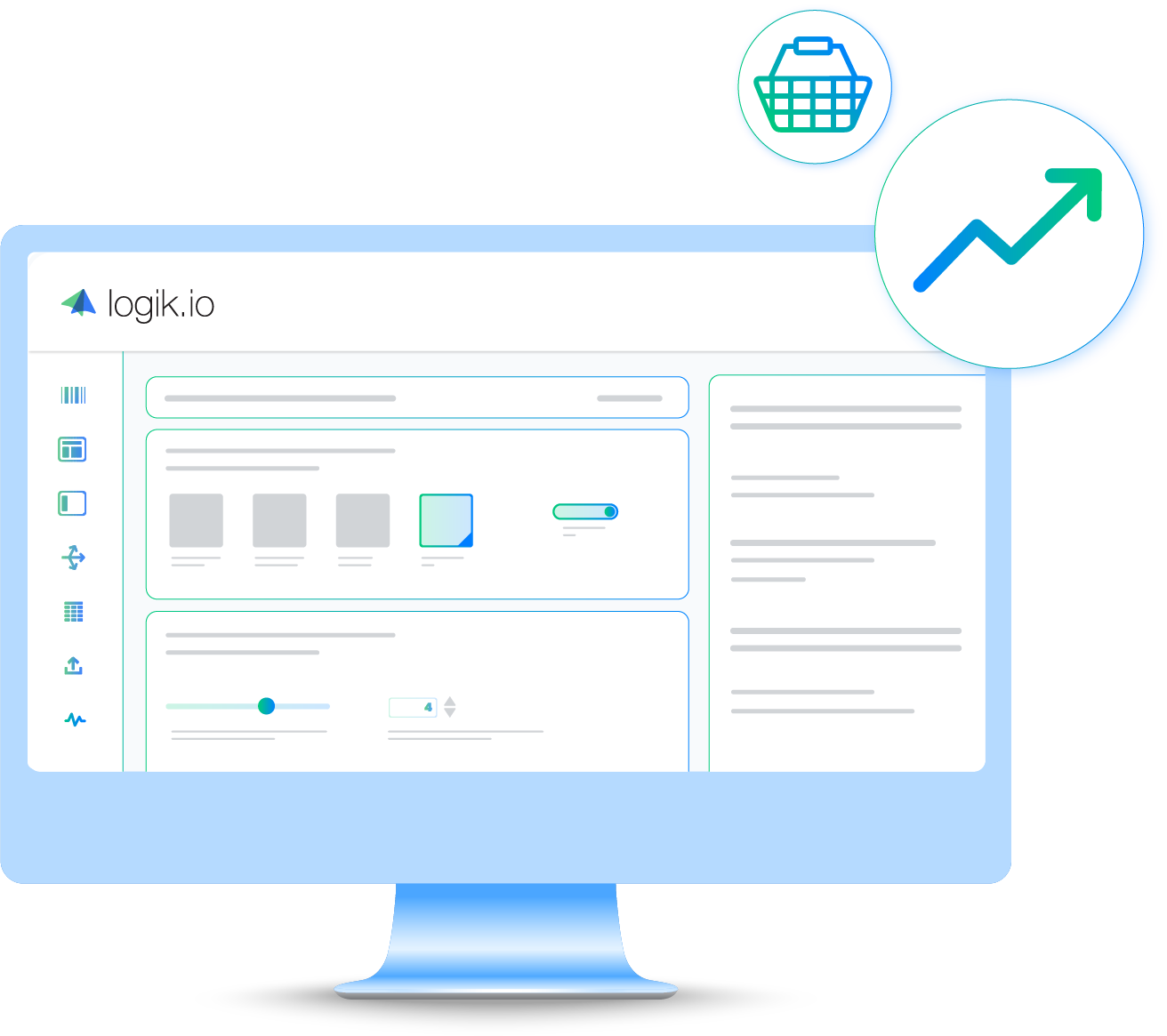Quote to Cash Management
Logik.io Makes Quote to Cash Easy to Manage
By providing an easy-to-manage, flexible, centralized solution for managing how products can and should be sold, businesses can accelerate their GTM agility, reduce system administration costs, and increase selling effectiveness across channels.

Why is Logik.io's Commerce Logic Engine for Product Configuration a Game-Changer?

Flexible & Intuitive
Give your sales reps the tool they need to deliver a quote for products and services that fit exactly what your customer needs. No more picking through part numbers and product lists. Let Logik.io guide every seller to the perfect solution.

Maintain a Single Source of Data
Logik.io enhances the "C" of Salesforce CPQ, and is built directly on the Salesforce platform and within the Salesforce data structure, so you can still leverage all your product data in one central place. Logik.io works right alongside your existing system.

Lightning Fast Speeds
Logik.io adds a proprietary solving engine to Salesforce CPQ built to handle advanced product configurations with split second speed speed for sales reps to produce quotes faster for every product, for every customer, every time.
Table of Contents
The State of B2B eCommerce Report
The needs and expectations of B2B buyers are evolving rapidly, and the demands for seamless self-service buying and e-commerce experiences are growing.
We compiled results that show that while there is a movement of early innovators who are prioritizing their eCommerce experience, and removing friction wherever possible, there is still a gap between buyer expectations and company execution when it comes to eCommerce.
Section 1 Quote to Cash Management
Over the past few years, many things have changed.
While anyone hearing that might feel that it's quite the understatement, nowhere is that sentiment truer than in the world of business. In fewer than three years, there has been a massive acceleration of the existing trajectory toward digitization and technological adoption.
While these progressions have been trending upward for quite some time, the pandemic has certainly hastened the process. Many businesses were reluctant to make the shift to eCommerce. However, the unique circumstances they faced in the wake of shutdowns left them no choice but to move much of their sales and communications online.
Luckily, once they did, they began to see all the advantages that came with doing so. Making such a drastic pivot required the implementation of several digital business solutions that were new to a great number of businesses. In learning about the kinds of technology available and what they had to offer, even some of the most stubborn businesses previously dead-set against such advancements began warming up to the idea.
Once they moved to an eCommerce sales model and saw what others were doing, they realized they needed to implement processes like configure, price, quote (CPQ) management to remain competitive. This allowed them to offer customizable products to their customers, provide a seamless guided selling process, and save time and money while also increasing sales.
By this point, most businesses have had enough time to consider and implement CPQ management. Now, it's on to quote to cash management. QTC management is the next major point of consideration for businesses looking forward.
There are various related and frequently overlapping terms that often get conflated in this discussion. Quote-to-cash vs order-to-cash (OTC), despite being very similar, do have important distinctions, as do order-to-cash vs opportunity-to-cash. However, since the quote to cash process is slightly more expansive than the order to cash or opportunity to cash process, that's where we'll mainly be focusing.
Section 2 Quote to Cash Meaning
As always, the best and most important place to start is with the basics.
In order to have any meaningful discussion about quote to cash management, we must first build a solid foundation of understanding. The natural place to start is by answering the question, what is the quote-to-cash process?
Quote to cash, often abbreviated as either Q2C or QTC, is a process that encompasses the entire sales process. It begins with the CPQ process when customers encounter either a sales rep or an eCommerce guided selling process. That is when they begin the process of configuring their product to build an accurate quote.
When first learning about the technical quote-to-cash meaning, many people assume due to the phrase quote to cash that it ends when customers make a payment. However, the quote to cash definition used by experts includes the allocation of those funds, the analysis and reporting of the resulting transaction data, and the subsequent iterations and improvements based on it.
The difference may seem trivial, but those final steps are crucial to success. That's why it's important to have a clear understanding of all the steps included in the QTC/Q2C meaning. Those final steps are critical to organizing a proper strategy for management.
When discussing order-to-cash vs quote-to-cash, many people get confused due to the fact that they include many of the same steps. While it's true that there's a lot more overlap between these two terms than there are differences, the nuances that differentiate them are important.
There's one key factor that distinguishes quote-to-cash from order-to-cash. While quote-to-cash starts with the CPQ process, the order-to-cash process doesn't begin until the customer places their order after the CPQ process is already complete. It may seem like a small distinction, but it's an important one.
Section 3 Quote to Cash Steps
The quote-to-cash steps help bring an order to fruition.
That's what makes each of the individual quote-to-cash process steps so important to any business. The goal of any business is to make sales and profits. Having an efficient quote-to-cash cycle makes that job much easier and more successful.
The quote-to-cash cycle includes several distinct touchpoints for administrators and buyers alike, unlike the order-to-cash process. OTC begins after a customer has made their purchase and there's already an order to be filled, the quote-to-cash process begins with the customer's intent to make a purchase, leading them from finding the right product, through the configuration process to tailor it to their needs, to the final purchase, and beyond.
There are many QTC companies offering this kind of solution. Because of how common quote-to-cash operations are, particularly in large-scale companies, it's important to find the right one for your business. Options are available from reputable business solution companies like Oracle and Salesforce.
Once you choose the ideal software for your needs, it's crucial to set it up properly. There are brand-specific resources on how QTC is integrated, so no matter which one you go with, the specific steps to install it will be available to you.
If you don't feel comfortable doing this yourself or you feel you lack the time, expertise, and/or qualified personnel to ensure that you use the software in a way that provides the most benefit, you can hire an expert to handle this for you. You may want to meet with quite a few candidates and have quote to cash interview questions prepared that are specific to your needs.
Typically, the more specialized their knowledge is, the better. There are many nuanced differences between each company's software and process, so it's best to find someone who knows how to deal with the exact system you're using. So, if you opt for Oracle, it would be helpful to ask applicants questions about their relevant experience with the quote to cash process in Oracle apps specifically.
Section 4 Quote to Cash Example
Understanding the difference between similar terms like the quote-to-cash process vs the quote-to-order process vs the order-to-cash process can be difficult to grasp at first.
A concrete quote-to-cash example can be helpful in providing a more tangible understanding. Plus, side-by-side examples of the quote-to-cash process, quote-to-order process, and order-to-cash process can help contextualize the differences.
Imagine that you're furniture shopping online. The quote-to-order process starts when you click on a link to configure your own living room set. You're then presented with options to choose from like the total seats and number of recliners.
After that, you pick the arrangement or "configuration" you like best. Next, you're presented with optional add-ons and accessories like cup holders, ottomans, and side tables. Dynamic pricing updates the displayed cost automatically each time you make a change. Finally, you choose the fabrics and colors.
Once you're finished, you're presented with a quote listing your items and the order total. You like the final product, and the price seems good, so you place your order. This is where the quote-to-order process ends.
The order-to-cash process begins when the store receives your order. They process it and create a fulfillment strategy by finding the closest warehouse with all the products in stock, packaging your order to your specifications, and arranging for a carrier to handle your shipment. Once delivered, they create an invoice, send it to you, and collect your payment.
They can then manage and analyze the data from your transaction to optimize their business and forecast future sales. That's where the order-to-cash process ends. The quote-to-cash process is the overarching lifecycle that encompasses both quote-to-order and order-to-cash. That's what makes QTC operations so integral to industries like eCommerce, retail, manufacturing, food and beverage, etc.
Section 5 Quote to Cash Salesforce
When it comes to software for quote-to-cash, Salesforce has the largest presence.
There are constant discussions regarding the best business software, and many companies have their own preferences based on their individual needs. In the conversation around the quote-to-cash process, SAP and Oracle also get brought up frequently. While the debate is never truly settled, Salesforce is typically considered the leader in the quote-to-cash management space.
QTC management can be tricky, especially for those new to using this kind of business software. However, there are plenty of resources available to help you through it. This includes the internal documentation and resources available from the brand you choose as well as several reputable external sources of information.
When you have comprehensive software with a thorough and detailed quote-to-cash process—Salesforce being a great example—it can be overwhelming to figure out all the steps and features at first. Luckily, Salesforce has a very complete library of resources like software documentation, help sections, and quote-to-cash Salesforce Trailhead.
These resources provide all the information you need to walk you through every step of the process. Their easy-to-use learning platform, Salesforce Trailhead, breaks everything down into courses with smaller, digestible lessons to teach you all about their system. With all of those helpful tools at your disposal, you'll be up and running in no time.
.gif?width=670&height=500&name=Guided%20Demo%20Featured%20Images%20(2).gif)
SHARE